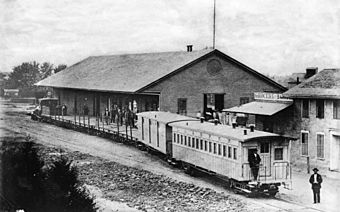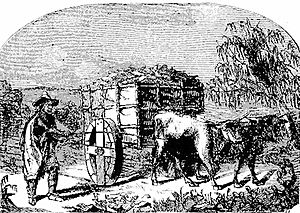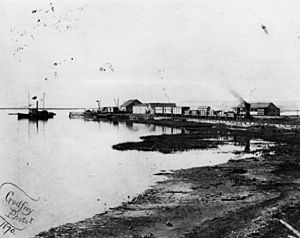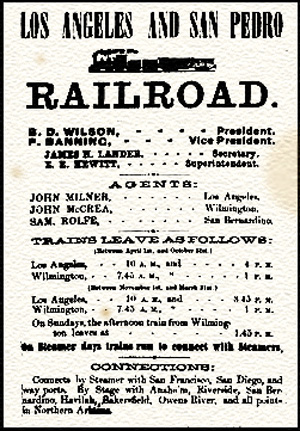- This page was last modified on 17 October 2025, at 10:18. Suggest an edit.
Los Angeles & San Pedro Railroad facts for kids

Los Angeles and San Pedro's Los Angeles station, c. 1880
|
|
| Overview | |
|---|---|
| Locale | San Pedro Bay to Los Angeles |
| Dates of operation | 1869–1873 |
| Predecessor | None |
| Successor | Southern Pacific |
| Technical | |
| Track gauge | 4 ft 8 in (1,422 mm) |
| Length | 21 miles (34 km) |
The Los Angeles & San Pedro Railroad was the very first railroad in Southern California. It built a 21-mile long line from San Pedro Bay to Los Angeles. Construction started in 1868, and the railroad began running trains on October 26, 1869.
This important railroad was the idea of Phineas Banning. Its main goal was to move goods from the port to the city. The Los Angeles & San Pedro Railroad was later bought by the Southern Pacific Railroad in 1873.
Contents
Building the First Railroad
For a long time, Los Angeles used the harbor at San Pedro Bay as its main port. Even though it wasn't the best harbor, it was the most useful one between San Diego and Santa Barbara. At first, people moved goods between the harbor and Los Angeles using oxcarts. Later, large wagons pulled by horses were also used.
Business leaders in Los Angeles knew that a railroad to the bay would be very helpful. As early as 1853, Phineas Banning saw the area near what is now Wilmington as a perfect spot. He thought it could be a major seaport and even a stop for a railroad that crossed the entire country.
Many plans for a railroad were discussed in the 1860s, but nothing happened. That changed when Phineas Banning became a state Senator. He introduced bills for the railroad in January 1868. These bills were approved by the state government and signed into law on February 1, 1868.
Getting Money for the Railroad
The new laws allowed Los Angeles County to invest $100,000 in the railroad. The City of Los Angeles could invest $75,000. An important rule was that the city and county could give their shares of the railroad to a larger, transcontinental railroad if it came to Los Angeles. The rest of the money needed, about $175,000, would come from selling shares to the public.
Two weeks after the laws passed, the first meeting of the railroad's investors was held. John G. Downey was chosen as president. The company officially started on February 18, 1868. The leaders then asked the city and county to vote on whether to approve the railroad's funding. This vote happened on March 24, 1868.
Some people in rural areas, like Anaheim and El Monte, were against the railroad. However, the funding was approved in Los Angeles County with a vote of 700 to 672. In Los Angeles City, it passed more easily with 347 votes for and 245 against.
Building the Tracks
Phineas Banning was first given the job to build the railroad. Construction officially began in Wilmington on September 20, 1868. Banning then hired H.B. Tichenor, a businessman from San Francisco, to actually build the tracks.
The land needed for the railroad from Los Angeles to Wilmington cost very little, only eight dollars. Most of the land was given for free or sold for tiny amounts. Landowners expected to benefit from the railroad passing through their property. The chosen path followed the San Pedro Road and Alameda Street. It went along the eastern side of Dominguez Hill. This route made John G. Downey leave the project, as he wanted the railroad to go through land he owned on the western side of Dominguez Hill.
By June 14, 1869, only 6 miles of track were finished. Farmers started to complain because they hoped to save money on shipping their large grain crops by railroad. More workers were hired, and by June 20, another 7 miles were built. By August 19, 18 miles of track were complete.
In February 1869, a place for the train station was bought in Los Angeles. It was at the corner of Alameda and Commercial Streets. The wharf in Wilmington was also improved. A new station, a warehouse, and a coal shed were added there.
The first train engine in Southern California was named the "San Gabriel." It started service when the line opened on October 26, 1869. This opening was celebrated with a special trip to Wilmington and a big party. Regular train service began on November 1, 1869. Trains left Los Angeles at 10 a.m. and 4 p.m., and Wilmington at 8 a.m. and 1 p.m. A ticket from Los Angeles to Wilmington cost $1.50.
How the Railroad Changed Things
The railroad made it cheaper to travel and ship goods between Los Angeles and Banning's Wilmington wharf. Passenger tickets from station to station cost $1.50. There was an extra $1.00 charge to go from the wharf to ships that couldn't dock in the shallow water. In the first six months, the railroad earned $61,847 from moving goods. This was a big improvement over the $171,988 it would have cost using older ways of transportation.
There were some disagreements about how the railroad was built and paid for. Some people also complained that the southern end of the line was not at a deep-water port. Some newspapers criticized the "Railroad Ring" and complained about high shipping prices. The city of Los Angeles even sued the railroad, but the lawsuit was later dropped.
Still, the railroad greatly helped Los Angeles grow. Remi Nadeau used the line to ship silver and lead from the Cerro Gordo Mines to the port at Wilmington. This increased ship traffic and made Wilmington a much busier port. New places like the Exchange Hotel and the Railroad Saloon were built there.
The railroad also helped new towns grow along its route. Florence, a farming community, started about 4 miles south of the Los Angeles station. Comptonville (later called Compton) was founded about 6 miles further south. Dominguez Station, 4 miles more, served the Dominguez family's ranch. And Cerritos was created 2 miles further south as a shipping point for the Cerritos sheep ranch.
In 1871, there were talks about extending the railroad to Anaheim and then through San Bernardino to Arizona or Utah. The U.S. Congress also approved $200,000 for a deep-water port on March 2, 1871.
Southern Pacific Takes Over
In 1872, the Southern Pacific Railroad was building a line south from San Francisco. Los Angeles was worried that this major railroad might completely skip their small city. So, Harris Newmark and John G. Downey met with Collis P. Huntington from Southern Pacific.
Huntington agreed to bring the main line through Los Angeles. But he asked for a special payment, which included the shares of the Los Angeles and San Pedro Railroad. This was allowed by a state law passed in 1870. This law let cities raise money to help build railroads. In return, Southern Pacific promised to build 50 miles of new lines connecting Los Angeles to other areas. They also agreed to run their main line through the city.
Most people liked this idea. A letter in the Los Angeles Star newspaper pointed out that the $525,000 cost of the payment was much less than the $4 million worth of new lines Southern Pacific would build. It also mentioned how property values might increase. Only Anaheim, which wanted a direct connection to a harbor, was against the plan. In July 1872, the city of Los Angeles agreed to give its shares in the Los Angeles and San Pedro Railroad to Southern Pacific. Finally, on November 5, 1872, voters across the county decided to accept Southern Pacific's offer. The final vote was 1,896 for Southern Pacific and 724 against.
The Los Angeles and San Pedro Railroad was officially transferred to the Southern Pacific on April 23, 1873. This deal gave Southern Pacific a railroad that was already making money. It also gave them control over the port facilities at Wilmington. This control lasted until the Los Angeles Terminal Railway broke their monopoly twenty years later.
After the Takeover
After taking over, Southern Pacific built a new station north of Los Angeles called the River Station. They then built a 25-mile line north to San Fernando. This line would eventually connect to their main line from San Francisco.
Southern Pacific also built a 25-mile line east to Spadra, near Pomona. This line would later connect to Southern Pacific's southern main route. Finally, they built a line southeast to Anaheim, which opened in January 1875.
When the main line to Los Angeles was finished on September 9, 1876, the Southern Pacific Railway had complete control over train travel in Los Angeles. This included routes within the city and to the harbor.
Locomotives (1869-1873)
| Original
Number |
Wheel
Arrangement |
Builder | Builder
Number |
Date Built | SP 1873
Number |
SP 1891
Number |
Disposition | Notes |
|---|---|---|---|---|---|---|---|---|
| 1 | 2-2-0 | Vulcan Iron Works | 1864 | 30 | Wrecked 1875, Scrapped 1876 | Purchased in 1868 or 1869 from the San Francisco and Alameda Railroad, Named San Gabriel | ||
| 2 | 4-4-0 | Schenectady Locomotive Works | 603 | 1869 | 34 | 1105 | Sold in 1894, final disposition unknown | |
| 3 | 4-4-0 | Schenectady Locomotive Works | 604 | 1869 | 32 | 1113 | Sold in 1891, final disposition unknown | |
| 4 | 4-4-0 | Schenectady Locomotive Works | 538 | 1869 | 31 | 1104 | Sold in 1894, final disposition unknown |



